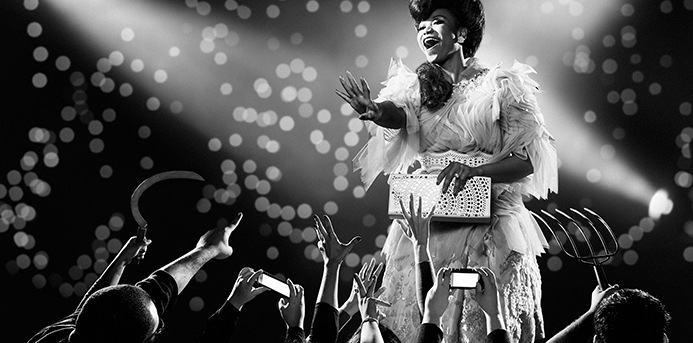Scene One. Marie Antoinette and her ladies drink tea and nibble on decadent French pastries as they walk back and forth across the golden “Hall of Mirrors” and chat frivolously about fashion, gardens and men. So begins Director Robert O’Hara’s modern and unconventional production of “Marie Antoinette” at Steppenwolf Theatre.
Playwright David Adjmi intends to present Marie Antoinette as a celebrity whose character is shaped by the court of Versailles, eighteenth century French society, and us—the contemporary audience who views her as the infamous historical icon of beauty, self-indulgence, thoughtlessness, and promiscuity. As the play unfolds, Adjmi reveals more about the oppressive society that created her and the budding revolutionary one that ultimately destroys her, and provides insights into Marie’s own personal struggles with her identity and desires.
O’Hara interprets Adjmi’s play with an unconventional production that combines both modern and historical elements. Starting off, all the lead female characters in the play are black, including Marie Antoinette, who is played by actress Alana Arenas. O’Hara brings in the issue of race to Marie Antoinette’s character, a woman who was valued mostly for her appearance, and it certainly takes the play out of its historical context and makes it feel more modern.
The production’s scenic design, led by Clint Ramos, was limited to a simple stage and two screens on either side that projected images of different settings: the Hall of Mirrors, the Versailles gardens, the open countryside, and the underground cell in which Marie awaited her execution at the end. The settings were not particularly captivating, especially since it was inconvenient to have to follow the actors and pay attention to the screens on either side of the stage at the same time (text was also projected on the screens, narrating certain historical events and the plot of the play itself). In my opinion, Ramos didn’t manage to do what every great scenic designer should: take their audience out of the theatre’s seats and transport them into the world of the play.
The stage props used throughout the production, however, added a touch of history that was much needed. From Louis XVI’s old-fashioned case with clock pieces to silver serving tables and platters with real desserts and pastries, these were as vibrant and fun to look at as the production’s costumes. Costume Designer Dede M. Ayite did an amazing job with the clothes and showed Marie Antoinette’s transformation from a young, naïve girl obsessed with material things to a more self-aware and independent individual taking ownership of her identity as the world around her begins to crumble. I thought the costumes were the most captivating and vibrant aspect of the play, especially when you could watch Arenas change outfits on stage (with other actors dressing her, taking off pieces of clothing from previous outfits and adding new ones). At these moments, the lights on stage would dim and loud, modern music would blast, pulling the audience out of the play and focusing their attention directly on Marie’s transformation.
Arenas played the iconic Marie with a lot of attitude, wit and emotion. She used the stage to her advantage throughout the performance as well, moving back and forth across it, and was very expressive in her gestures. However, her character didn’t seem genuine enough, and I found it hard to sympathize with her demise at the end. Arenas played the character more aggressively and with too much sarcastic wit and backhanded comments. I would imagine the real Marie to have been much more refined and intelligent, while also ignorant and young.
Tim Hopper’s performance as King Louis XVI was more realistic in terms of how the king has been traditionally thought of throughout history: a weak and timid man obsessed with clocks. Hopper wears glasses, appears hunched over and acts very nervous, creating a character that seems much more vulnerable than his strong-willed wife.
Alan Wilder played the most unusual character in the show, a sheep who seemed to be the voice of reason and guidance for Marie Antoinette, although it wasn’t really clear what his purpose was. Wilder played the character as philosophical and funny, appearing at key times during Marie’s struggles, including at the end when she waits in jail, and makes you wonder how much he is real or just a figment of Marie’s imagination.
The characters’ dialogue throughout the play is filled with witty and sarcastic remarks that are very funny, like Marie Antoinette’s reference to the “Blois de Baloney” instead of the “Blois de Bologne,” or when she tells Louis that “We are great friends, you and I” as opposed to the husband and wife or lovers they’re supposed to be. O’Hara also provides insight into Marie’s personal struggles through dialogue, including when she says, “I feel like a game that other people play without me,” or “Sometimes I feel like I’m not even a person.”
Steppenwolf’s “Marie Antoinette” is an unconventional approach to the eighteenth century queen and her iconic demise. It is bold and interesting in a lot of ways, but in the end fails to deliver a more serious, meaningful and thoughtful message.
“Marie Antoinette” runs through May 10 at Steppenwolf Theatre, 1650 N. Halsted St., Chicago. For tickets and more information, visit Steppenwolf’s website.

